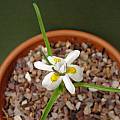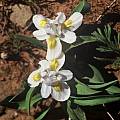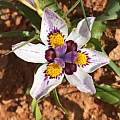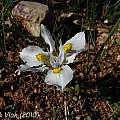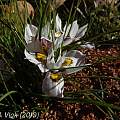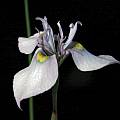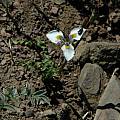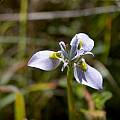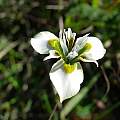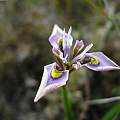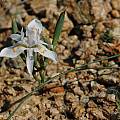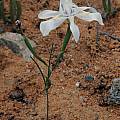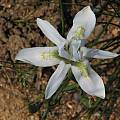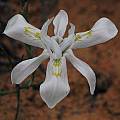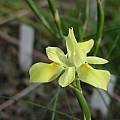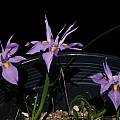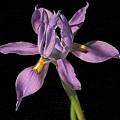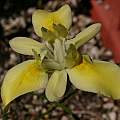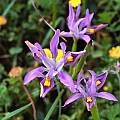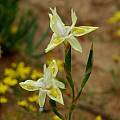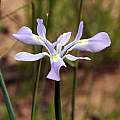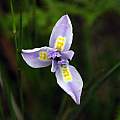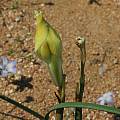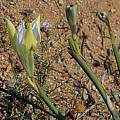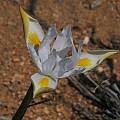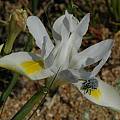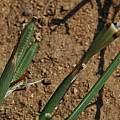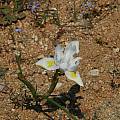The genus Moraea can be divided into five groups: Galaxia, Gynandriris, Hexaglottis and Homeria, and Moraea.
Moraea group species f are found on this wiki page. More information can be learned from Peter Goldblatt's book on Moraeas.
Moraea index lists all the species in all five groups alphabetically.
The other species in the Moraea group are listed alphabetically on these wiki pages: Moraea group a - Moraea group b - Moraea group c-e - Moraea group g-i - Moraea group j-m - Moraea group n-r - Moraea group s - Moraea group t - Moraea group u-v
Moraea falcifolia Klatt grows on sandy or clay slopes and flats from southern Namibia to the Karoo and south to the southwestern Cape. It is a short plant (to 5 cm) with several leaves often with wavy margins and white short lived flowers with yellow nectar guides on the outer tepals and purple or yellow blotches on the inner tepals. It flowers from winter to early spring. It is difficult to grow. The first two photos by Audrey Cain and Rod Saunders. The second two photos were taken by Brian du Preez in Namaqualand. The last two photos from the book Plants of the Klein Karoo courtesy of Jan and Anne Lise Schutte-Vlok.
Moraea fergusoniae L.Bolus grows on clay slopes in the southwest Cape in renosterveld and has short lived white or blue flowers with yellow nectar guides. The first two photos were taken by Bob Werra. The third photo from Bob Rutemoeller shows one flowering in August 2006 near Villiersdorp. Some of the leaves were curled and some were not and there was a range of heights as well. The last three photos by Cameron McMaster were taken in the Overberg.
Moraea filamentosa Goldblatt & J.C.Manning is a dwarf species under 20 mm tall described in 2013. It has been collected only twice, in the desert north of Loeriesfontein in the Northern Cape. It blooms in early winter (May). Flowers are "possibly white." It's notable for its long thready flower bracts that are visible among the leaves. The leaves are distinctive with broad, membranous sheaths and falcate, channelled blades. This species is probably related to Moraea falcifolia.
Moraea filicaulis Baker, syn. Moraea fugax ssp. filicaulis (Baker) Goldblatt, is found from Namaqualand south to Clanwilliam. It grows in rocky ground or deep sand and flowers August to October. It has 2 filiform leaves and white flowers, rarely blue violet, with yellow nectar guides. The plant and flowers are smaller than the other subspecies. Photographed September 2006 in Namaqualand by Bob Rutemoeller and Mary Sue Ittner.
Moraea fugax (D.Delaroche) Jacq. grows in deep sands and rocky sandstone and granitic soils in the winter rainfall areas of South Africa. It is distinguished by having a beaked ovary and leaf or leaves inserted high on the stem. The fugacious flowers open near midday and close around sunset. Flowers are blue, white, or yellow. It flowers from August to December depending partly on the elevation. It usually has one but occasionally two channeled linear trailing leaf/leaves and larger flower than the other subspecies. The first photo of a yellow form was taken by Jana Ulmer and the next three photos were taken by Bob Werra. Corm photo by Michael Mace.
The first picture was taken of a blue one in the wild in the West Coast National Park in 2001 and the next of a yellow one in Namaqualand. Photos by Mary Sue Ittner. Bob Rutemoeller took the next two September 2006 in the Cederberg of one with white flowers.
These photos showing many different color forms of plants blooming in the same area near Bainskloof were taken by Mary Sue Ittner September 2006.
The following series of photos were taken in Namaqualand September 2006 by Bob Rutemoeller and Mary Sue Ittner showing the progression of the flowers as they open mid day. We watched them slowly unfold within minutes and by the time they were finally open there was already a pollinator in place. The final pictures show the seed pods (found on plants that had earlier blooms) and a picture of the whole plant. Most of these pictures also show that these plants have bloomed before as there are spent blooms.
Galaxia - Gynandriris - Hexaglottis - Homeria a-j - Homeria k-z - Moraea group a - Moraea group b - Moraea group c-e - Moraea group g-i - Moraea group j-m - Moraea group n-r - Moraea group s - Moraea group t - Moraea group u-v - Moraea hybrids - Moraea index
